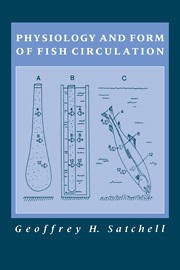Book contents
- Frontmatter
- Contents
- Preface
- 1 Introduction
- 2 The Heart
- 3 The peripheral circulation
- 4 The blood
- 5 Haemopoiesis and phagocytosis - the mononuclear phagocytic system
- 6 Circulation through special regions
- 7 Retial counter-current systems: flow–diffusion–concentration
- 8 Venous return and venous pumps
- 9 The autonomic nervous system
- 10 The response to exercise
- 11 The response to hypoxia
- 12 Myxine, a speculative conclusion
- References
- Appendix of popular and scientific names
- Index
7 - Retial counter-current systems: flow–diffusion–concentration
Published online by Cambridge University Press: 05 February 2012
- Frontmatter
- Contents
- Preface
- 1 Introduction
- 2 The Heart
- 3 The peripheral circulation
- 4 The blood
- 5 Haemopoiesis and phagocytosis - the mononuclear phagocytic system
- 6 Circulation through special regions
- 7 Retial counter-current systems: flow–diffusion–concentration
- 8 Venous return and venous pumps
- 9 The autonomic nervous system
- 10 The response to exercise
- 11 The response to hypoxia
- 12 Myxine, a speculative conclusion
- References
- Appendix of popular and scientific names
- Index
Summary
Introduction
In fish, arteries and veins often run side by side in the restricted spaces around or between skeletal elements or muscle masses. The afferent and efferent branchial arteries alongside the gill arches, the dorsal aorta and posterior cardinal veins beneath the spine, and the caudal artery and vein within the haemal canal are examples of this. Smaller vessels derived from these become similarly juxtaposed and their thin walls may be enclosed in a common connective tissue sheath. Such close proximity may make it possible for agents such as heat and oxygen to diffuse across the walls from one stream of blood into the other.
A characteristic feature of some fish blood systems is the occurrence of masses or slabs of highly vascular tissue, consisting of parallel arrays of arterial and venous vessels, of capillary or arteriolar dimensions. These vessels may have a mosaic or hexagonal packing so that each arterial vessel is bordered by a venous one, and their walls have the maximum possible contact. Such structures are called retia mirabilia, and they are strategically located in the ciculatory system so that the blood both to and from some tissue or organ must pass through them. The blood flows in opposite directions in the two sets of vessels, and thus makes possible a counter-current exchange of any agent that can diffuse across the thin boundary between them. The most studied retia are those of the swimbladder which, in deep-water fish, may contain oxygen at a pressure of 200 atm. A rete restricts the loss of some agent, oxygen or heat, which would otherwise be carried away in the venous blood; it imposes a high resistance to its dispersion.
- Type
- Chapter
- Information
- Physiology and Form of Fish Circulation , pp. 106 - 125Publisher: Cambridge University PressPrint publication year: 1991



